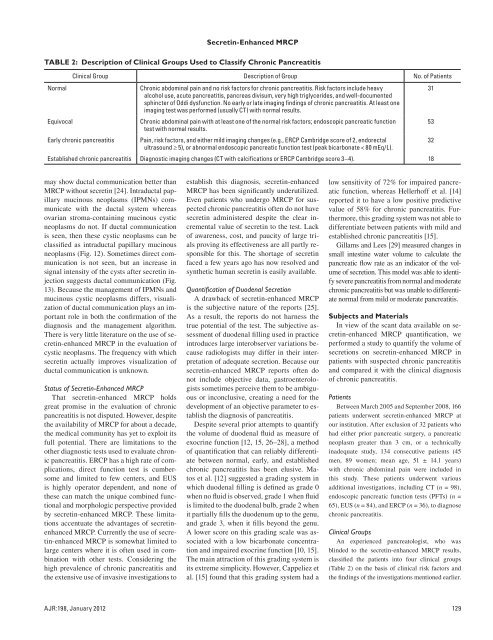Secretin-Enhanced MRCP: Review of Technique and Application ...
Secretin-Enhanced MRCP: Review of Technique and Application ...
Secretin-Enhanced MRCP: Review of Technique and Application ...
Create successful ePaper yourself
Turn your PDF publications into a flip-book with our unique Google optimized e-Paper software.
<strong>Secretin</strong>-<strong>Enhanced</strong> <strong>MRCP</strong>TABLE 2: Description <strong>of</strong> Clinical Groups Used to Classify Chronic PancreatitisClinical Group Description <strong>of</strong> Group No. <strong>of</strong> PatientsNormalChronic abdominal pain <strong>and</strong> no risk factors for chronic pancreatitis. Risk factors include heavy31alcohol use, acute pancreatitis, pancreas divisum, very high triglycerides, <strong>and</strong> well-documentedsphincter <strong>of</strong> Oddi dysfunction. No early or late imaging findings <strong>of</strong> chronic pancreatitis. At least oneimaging test was performed (usually CT) with normal results.EquivocalChronic abdominal pain with at least one <strong>of</strong> the normal risk factors; endoscopic pancreatic function53test with normal results.Early chronic pancreatitis Pain, risk factors, <strong>and</strong> either mild imaging changes (e.g., ERCP Cambridge score <strong>of</strong> 2, endorectal32ultrasound ≥ 5), or abnormal endoscopic pancreatic function test (peak bicarbonate < 80 mEq/L).Established chronic pancreatitis Diagnostic imaging changes (CT with calcifications or ERCP Cambridge score 3–4). 18may show ductal communication better than<strong>MRCP</strong> without secretin [24]. Intraductal papillarymucinous neoplasms (IPMNs) communicatewith the ductal system whereasovarian stroma-containing mucinous cysticneoplasms do not. If ductal communicationis seen, then these cystic neoplasms can beclassified as intraductal papillary mucinousneoplasms (Fig. 12). Sometimes direct communicationis not seen, but an increase insignal intensity <strong>of</strong> the cysts after secretin injectionsuggests ductal communication (Fig.13). Because the management <strong>of</strong> IPMNs <strong>and</strong>mucinous cystic neoplasms differs, visualization<strong>of</strong> ductal communication plays an importantrole in both the confirmation <strong>of</strong> thediagnosis <strong>and</strong> the management algorithm.There is very little literature on the use <strong>of</strong> secretin-enhanced<strong>MRCP</strong> in the evaluation <strong>of</strong>cystic neoplasms. The frequency with whichsecretin actually improves visualization <strong>of</strong>ductal communication is unknown.Status <strong>of</strong> <strong>Secretin</strong>-<strong>Enhanced</strong> <strong>MRCP</strong>That secretin-enhanced <strong>MRCP</strong> holdsgreat promise in the evaluation <strong>of</strong> chronicpancreatitis is not disputed. However, despitethe availability <strong>of</strong> <strong>MRCP</strong> for about a decade,the medical community has yet to exploit itsfull potential. There are limitations to theother diagnostic tests used to evaluate chronicpancreatitis. ERCP has a high rate <strong>of</strong> complications,direct function test is cumbersome<strong>and</strong> limited to few centers, <strong>and</strong> EUSis highly operator dependent, <strong>and</strong> none <strong>of</strong>these can match the unique combined functional<strong>and</strong> morphologic perspective providedby secretin-enhanced <strong>MRCP</strong>. These limitationsaccentuate the advantages <strong>of</strong> secretinenhanced<strong>MRCP</strong>. Currently the use <strong>of</strong> secretin-enhanced<strong>MRCP</strong> is somewhat limited tolarge centers where it is <strong>of</strong>ten used in combinationwith other tests. Considering thehigh prevalence <strong>of</strong> chronic pancreatitis <strong>and</strong>the extensive use <strong>of</strong> invasive investigations toestablish this diagnosis, secretin-enhanced<strong>MRCP</strong> has been significantly underutilized.Even patients who undergo <strong>MRCP</strong> for suspectedchronic pancreatitis <strong>of</strong>ten do not havesecretin administered despite the clear incrementalvalue <strong>of</strong> secretin to the test. Lack<strong>of</strong> awareness, cost, <strong>and</strong> paucity <strong>of</strong> large trialsproving its effectiveness are all partly responsiblefor this. The shortage <strong>of</strong> secretinfaced a few years ago has now resolved <strong>and</strong>synthetic human secretin is easily available.Quantification <strong>of</strong> Duodenal SecretionA drawback <strong>of</strong> secretin-enhanced <strong>MRCP</strong>is the subjective nature <strong>of</strong> the reports [25].As a result, the reports do not harness thetrue potential <strong>of</strong> the test. The subjective assessment<strong>of</strong> duodenal filling used in practiceintroduces large interobserver variations becauseradiologists may differ in their interpretation<strong>of</strong> adequate secretion. Because oursecretin-enhanced <strong>MRCP</strong> reports <strong>of</strong>ten donot include objective data, gastroenterologistssometimes perceive them to be ambiguousor inconclusive, creating a need for thedevelopment <strong>of</strong> an objective parameter to establishthe diagnosis <strong>of</strong> pancreatitis.Despite several prior attempts to quantifythe volume <strong>of</strong> duodenal fluid as measure <strong>of</strong>exocrine function [12, 15, 26–28], a method<strong>of</strong> quantification that can reliably differentiatebetween normal, early, <strong>and</strong> establishedchronic pancreatitis has been elusive. Matoset al. [12] suggested a grading system inwhich duodenal filling is defined as grade 0when no fluid is observed, grade 1 when fluidis limited to the duodenal bulb, grade 2 whenit partially fills the duodenum up to the genu,<strong>and</strong> grade 3, when it fills beyond the genu.A lower score on this grading scale was associatedwith a low bicarbonate concentration<strong>and</strong> impaired exocrine function [10, 15].The main attraction <strong>of</strong> this grading system isits extreme simplicity. However, Cappeliez etal. [15] found that this grading system had alow sensitivity <strong>of</strong> 72% for impaired pancreaticfunction, whereas Hellerh<strong>of</strong>f et al. [14]reported it to have a low positive predictivevalue <strong>of</strong> 58% for chronic pancreatitis. Furthermore,this grading system was not able todifferentiate between patients with mild <strong>and</strong>established chronic pancreatitis [15].Gillams <strong>and</strong> Lees [29] measured changes insmall intestine water volume to calculate thepancreatic flow rate as an indicator <strong>of</strong> the volume<strong>of</strong> secretion. This model was able to identifysevere pancreatitis from normal <strong>and</strong> moderatechronic pancreatitis but was unable to differentiatenormal from mild or moderate pancreatitis.Subjects <strong>and</strong> MaterialsIn view <strong>of</strong> the scant data available on secretin-enhanced<strong>MRCP</strong> quantification, weperformed a study to quantify the volume <strong>of</strong>secretions on secretin-enhanced <strong>MRCP</strong> inpatients with suspected chronic pancreatitis<strong>and</strong> compared it with the clinical diagnosis<strong>of</strong> chronic pancreatitis.PatientsBetween March 2005 <strong>and</strong> September 2008, 166patients underwent secretin-enhanced <strong>MRCP</strong> atour institution. After exclusion <strong>of</strong> 32 patients whohad either prior pancreatic surgery, a pancreaticneoplasm greater than 3 cm, or a technicallyinadequate study, 134 consecutive patients (45men, 89 women; mean age, 51 ± 14.1 years)with chronic abdominal pain were included inthis study. These patients underwent variousadditional investigations, including CT (n = 98),endoscopic pancreatic function tests (PFTs) (n =65), EUS (n = 84), <strong>and</strong> ERCP (n = 36), to diagnosechronic pancreatitis.Clinical GroupsAn experienced pancreatologist, who wasblinded to the secretin-enhanced <strong>MRCP</strong> results,classified the patients into four clinical groups(Table 2) on the basis <strong>of</strong> clinical risk factors <strong>and</strong>the findings <strong>of</strong> the investigations mentioned earlier.AJR:198, January 2012 129


